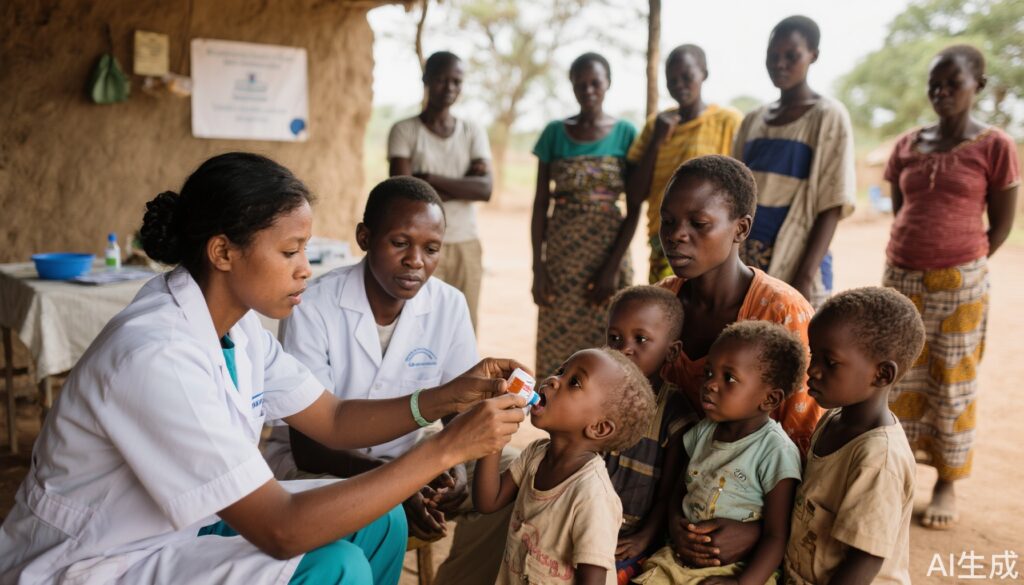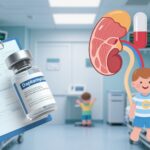Highlights
- Mass drug administration (MDA) of azithromycin to children aged 1–59 months reduced infant (1–11 months) mortality by 23% compared to placebo.
- Adding azithromycin treatment for older siblings (12–59 months) provided an incremental mortality reduction among infants beyond direct treatment alone.
- Spillover benefits from treating siblings accounted for roughly three-quarters of the observed mortality reduction.
- Although the interaction between sibling treatment and infant mortality was not statistically significant, there was a trend toward lower mortality in infants living with treated older siblings.
Study Background and Disease Burden
Infant and child mortality remain pressing public health concerns in sub-Saharan Africa, with infectious diseases such as pneumonia, diarrhea, and malaria accounting for a substantial proportion of deaths. Despite advances in immunization and healthcare access, the under-five mortality rate in many regions of Niger and similar settings remains high. Mass drug administration (MDA) of azithromycin—a broad-spectrum macrolide antibiotic—has previously demonstrated mortality benefits in children but the optimal population for targeting and possible indirect benefits (spillover effects) remain areas of investigation. Understanding whether treating older siblings enhances the survival benefit for infants could inform public health MDA strategies.
Study Design
This report presents a secondary analysis of a large, cluster-randomized, placebo-controlled trial conducted in Niger from November 2020 to July 2023 (Arzika et al., JAMA Netw Open 2025). The study enrolled 98,969 infants aged 1–11 months (minimum weight 3 kg, no known macrolide allergy). Participants were randomly assigned by community to one of three arms:
- Child arm: All infants (1–11 months) and children (12–59 months) received azithromycin (20 mg/kg orally) biannually.
- Infant arm: Only infants (1–11 months) received azithromycin; older children (12–59 months) received placebo.
- Placebo arm: All children (1–59 months) received placebo.
The primary endpoint was all-cause mortality among infants aged 1–11 months over 2 years, stratified by the presence or absence of older siblings (12–59 months) in the household.
Key Findings
Overall Mortality Reduction
The community-level infant mortality rate per 1000 person-years at risk was:
- 18.5 deaths (95% CI, 16.7–20.4) in the child arm
- 22.3 deaths (95% CI, 20.0–24.7) in the infant arm
- 23.9 deaths (95% CI, 21.6–26.2) in the placebo arm
This translates to a 23% reduction in infant mortality (95% CI, 11%–33%) in communities where azithromycin was administered versus placebo.
Direct and Indirect Effects
Of the overall mortality reduction, only 23.5% (95% CI, 1.2%–72.7%) was directly attributable to treating infants, while the remaining 76.5% (95% CI, 27.3%–98.8%) was due to also treating older children (potentially older siblings). This finding suggests that most of the mortality benefit derives from a community-wide treatment approach, possibly through reduced transmission of infectious agents within households.
Data are shown for the child arm, with biannual azithromycin administration to infants and children aged 1 to 59 months, and the infant arm, with biannual azithromycin administration to infants aged 1 to 11 months and placebo administration to children aged 12 to 59 months. Mortality incidence rates, incidence rate ratios (IRRs), and incidence rate differences (IRDs) are compared among infants aged 1 to 11 months by treatment arm and presence of an older sibling (12-59 months of age) in the household. IRRs comparing mortality rate by arm and presence of a sibling were estimated using Poisson regression accounting for the adaptation and clustering. IRDs comparing mortality by arm and presence of an older sibling were estimated using G-computation based on the Poisson model. Supportive data are found in eTable 2 in Supplement 2.
Data are shown for the placebo arm, with biannual administration of placebo to infants and children aged 1 to 59 months, and the infant arm, with biannual azithromycin administration to infants aged 1 to 11 months and placebo administration to children aged 12 to 59 months. Mortality incidence rates, incidence rate ratios (IRRs), and incidence rate differences (IRDs) are compared among infants aged 1 to 11 months by treatment arm and presence of an older sibling (12-59 months of age) in the household. IRRs comparing mortality rate by arm and presence of a sibling were estimated using Poisson regression accounting for the adaptation and clustering. IRDs comparing mortality by arm and presence of an older sibling were estimated using G-computation based on the Poisson model. Supportive data are found in eTable 2 in Supplement 2.
Impact of Sibling Treatment
Among infants with older siblings in the household, the incidence rate ratio (IRR) for mortality when comparing the child arm (everyone treated) to the infant arm (only infants treated) was 0.78 (95% CI, 0.65–0.93), indicating a 22% lower mortality rate when older siblings were also treated. For infants without older siblings, the IRR was 0.91 (95% CI, 0.73–1.15), suggesting a smaller and statistically non-significant reduction. The interaction P-value was 0.26, meaning the statistical evidence for effect modification by sibling presence was not strong, but the trend hints at a clinically meaningful spillover effect.
Safety
No new or unexpected safety signals were reported in this secondary analysis. Previous studies have shown that biannual azithromycin MDA is generally well tolerated in children.
Expert Commentary
The findings from this large, pragmatic trial reinforce the importance of a community-wide approach to infectious disease control in high-mortality settings. While direct treatment of infants is beneficial, the additional mortality reduction observed when older siblings are also treated suggests a significant spillover or herd effect, likely mediated by decreased transmission of bacterial pathogens within households. This aligns with the concept of indirect protection, akin to that seen with some vaccination programs.
However, it is important to note that the statistical interaction between sibling treatment and infant mortality was not significant, indicating that while the trend is evident, it should be interpreted with caution. Other factors, such as household structure, disease transmission dynamics, and local epidemiology, may also influence these outcomes. The authors appropriately recommend that, to maximize survival benefits, MDA strategies should target all children aged 1–59 months rather than infants alone.
Caveats to broad azithromycin use include the potential for antimicrobial resistance, which remains a public health concern and warrants ongoing monitoring. Additionally, while the spillover effect is suggested, further research is needed to clarify the mechanisms (e.g., reduction in pathogen carriage, changes in household transmission networks) and to assess the long-term sustainability and safety of repeated MDA campaigns.
Conclusion
Mass administration of azithromycin to both infants and older children significantly reduces infant mortality in high-burden settings, with a substantial proportion of the benefit likely attributable to indirect, spillover effects from treating older siblings. These findings support WHO and national policy guidelines favoring broad MDA for childhood survival in select regions, but highlight the need for careful stewardship and ongoing evaluation of resistance patterns. Further studies should explore the mechanisms underlying household-level spillover and optimize strategies for maximal public health impact.
References
Arzika AM, Amza A, Maliki R, Aichatou B, Bello IM, Beidi D, Galo N, Harouna N, Karamba AM, Mahamadou S, Abarchi M, Ibrahim A, Brandt C, Lebas E, Peterson B, Liu Z, Oldenburg CE, Doan T, Porco TC, Arnold BF, Lietman TM, O’Brien KS. Spillover of Azithromycin Mass Drug Administration and Child Survival: A Secondary Analysis of a Cluster-Randomized Clinical Trial. JAMA Netw Open. 2025 Jul 1;8(7):e2519693. doi: 10.1001/jamanetworkopen.2025.19693 IF: 9.7 Q1 IF: 9.7 Q1 . PMID: 40638118 IF: 9.7 Q1 ; PMCID: PMC12246876 IF: 9.7 Q1 .





